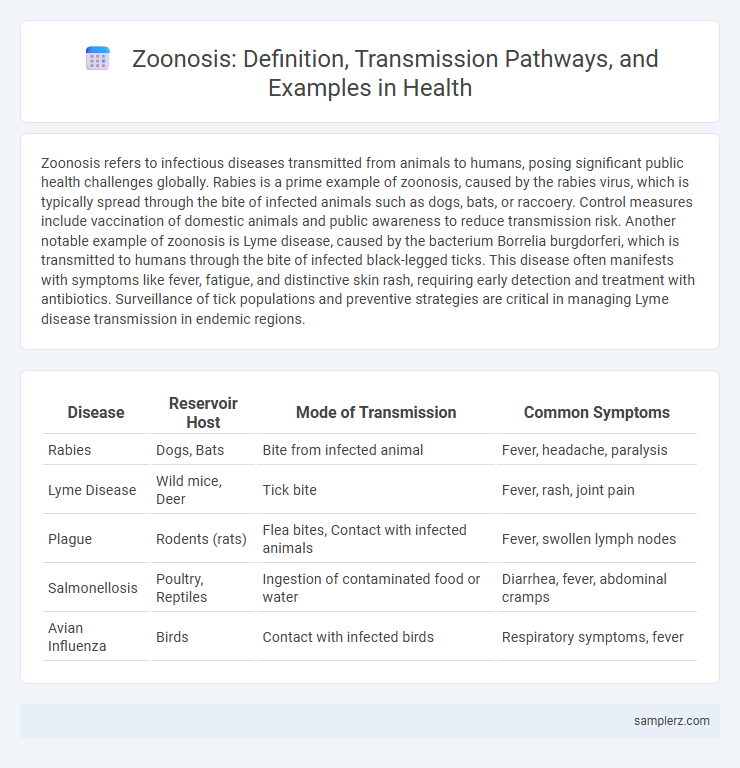Zoonosis refers to infectious diseases transmitted from animals to humans, posing significant public health challenges globally. Rabies is a prime example of zoonosis, caused by the rabies virus, which is typically spread through the bite of infected animals such as dogs, bats, or raccoery. Control measures include vaccination of domestic animals and public awareness to reduce transmission risk. Another notable example of zoonosis is Lyme disease, caused by the bacterium Borrelia burgdorferi, which is transmitted to humans through the bite of infected black-legged ticks. This disease often manifests with symptoms like fever, fatigue, and distinctive skin rash, requiring early detection and treatment with antibiotics. Surveillance of tick populations and preventive strategies are critical in managing Lyme disease transmission in endemic regions.
Table of Comparison
| Disease | Reservoir Host | Mode of Transmission | Common Symptoms |
|---|---|---|---|
| Rabies | Dogs, Bats | Bite from infected animal | Fever, headache, paralysis |
| Lyme Disease | Wild mice, Deer | Tick bite | Fever, rash, joint pain |
| Plague | Rodents (rats) | Flea bites, Contact with infected animals | Fever, swollen lymph nodes |
| Salmonellosis | Poultry, Reptiles | Ingestion of contaminated food or water | Diarrhea, fever, abdominal cramps |
| Avian Influenza | Birds | Contact with infected birds | Respiratory symptoms, fever |
Overview of Zoonosis: Defining Animal-to-Human Transmission
Zoonosis refers to infectious diseases that naturally transmit from animals to humans, including pathogens like viruses, bacteria, parasites, and fungi. Rabies, Lyme disease, and avian influenza exemplify common zoonotic diseases, illustrating direct or vector-borne transmission routes. Understanding zoonotic transmission is essential for public health strategies aimed at controlling outbreaks and preventing emerging infectious diseases.
Bacterial Zoonotic Diseases: Common Examples
Bacterial zoonotic diseases frequently transmitted from animals to humans include Salmonellosis, caused by Salmonella bacteria commonly found in reptiles and poultry, and Leptospirosis, resulting from contact with water contaminated by the urine of infected animals such as rodents. Another significant example is Brucellosis, transmitted through unpasteurized dairy products from infected livestock, leading to fever and joint pain. These diseases highlight the importance of proper hygiene and animal handling to prevent zoonotic bacterial infections.
Viral Zoonosis: Key Infectious Agents
Rabies, caused by the Lyssavirus, is a prime example of viral zoonosis transmitted through animal bites, primarily from dogs and bats. Hantavirus Pulmonary Syndrome results from exposure to aerosolized excreta of infected rodents, illustrating rodent-to-human viral transmission. Ebola virus, originating from fruit bats, demonstrates viral zoonosis via direct contact with infected wildlife or bodily fluids, posing significant public health risks.
Parasitic Zoonotic Infections and Their Pathways
Parasitic zoonotic infections such as toxoplasmosis, caused by *Toxoplasma gondii*, are transmitted primarily through ingestion of contaminated food or water contaminated with oocysts from cat feces. Another example includes echinococcosis, resulting from *Echinococcus* tapeworm larvae transmitted via contact with infected dogs or consumption of contaminated produce. These pathways highlight critical public health concerns in controlling parasite transmission between animals and humans.
Fungal Zoonosis: Notable Cases and Impact
Fungal zoonosis such as Cryptococcosis, caused by Cryptococcus neoformans, commonly spreads from bird droppings to humans, leading to severe respiratory and neurological infections. Histoplasmosis, transmitted through inhalation of spores from soil contaminated by bat or bird guano, represents another significant example with global health implications. These fungal diseases highlight the critical need for monitoring animal reservoirs to prevent transmission and reduce public health risks.
Rabies: Classic Example of Direct Animal-to-Human Spread
Rabies exemplifies zoonotic disease transmission through direct contact, primarily via bites from infected animals such as dogs, bats, or raccoons. The rabies virus targets the central nervous system, causing fatal encephalitis if untreated before symptom onset. Vaccination and prompt post-exposure prophylaxis remain critical for preventing rabies transmission from animals to humans.
Avian Influenza: Birds as Vectors of Viral Transmission
Avian Influenza serves as a prominent example of zoonosis, where birds act as primary vectors in viral transmission to humans and other species. The virus spreads through direct contact with infected poultry, contaminated surfaces, or inhalation of aerosolized secretions, posing significant public health risks. Monitoring wild and domestic bird populations is crucial for early detection and outbreak prevention of avian influenza strains with pandemic potential.
Brucellosis: Livestock as Sources of Human Infection
Brucellosis is a zoonotic disease primarily transmitted to humans through direct contact with infected livestock, such as cattle, goats, sheep, and pigs, or consumption of unpasteurized dairy products. The causative agents are bacteria from the genus Brucella, which infect livestock via reproductive fluids, leading to abortions and infertility, increasing the risk of human exposure. Occupational groups like farmers, veterinarians, and abattoir workers are at higher risk due to close interaction with infected animals and contaminated animal products.
Leptospirosis: Rodent-Borne Zoonotic Risks
Leptospirosis is a rodent-borne zoonotic disease caused by the Leptospira bacteria, which humans can contract through contact with water or soil contaminated by infected rodent urine. This transmission mechanism highlights the significant public health risks in urban and rural areas where rodent populations thrive and sanitation is poor. Effective control of leptospirosis requires rodent control measures, public awareness, and improved sanitation to reduce environmental exposure to contaminated sources.
Preventing Zoonotic Transmission: Best Practices in Public Health
Preventing zoonotic transmission requires rigorous hygiene practices, including regular handwashing after animal contact and proper sanitation in livestock environments. Vaccination programs targeting both humans and animals, such as rabies immunization, play a crucial role in controlling zoonotic diseases. Public health education focusing on safe handling of animals and monitoring wildlife reservoirs further reduces the risk of zoonotic outbreaks.

example of zoonosis in transmission Infographic
 samplerz.com
samplerz.com